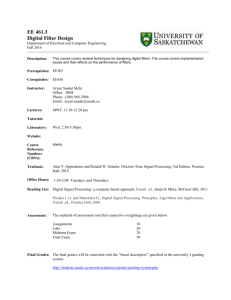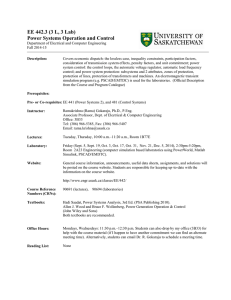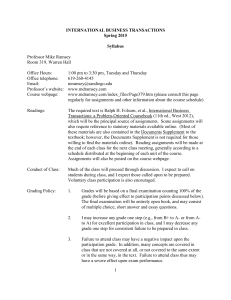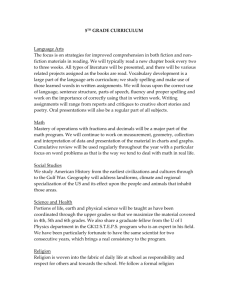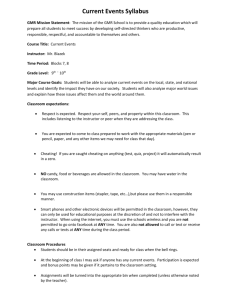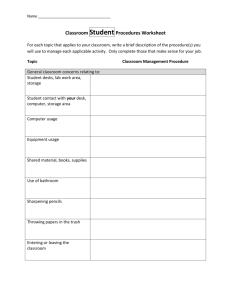ECE Course Outline Template - University of Saskatchewan
advertisement
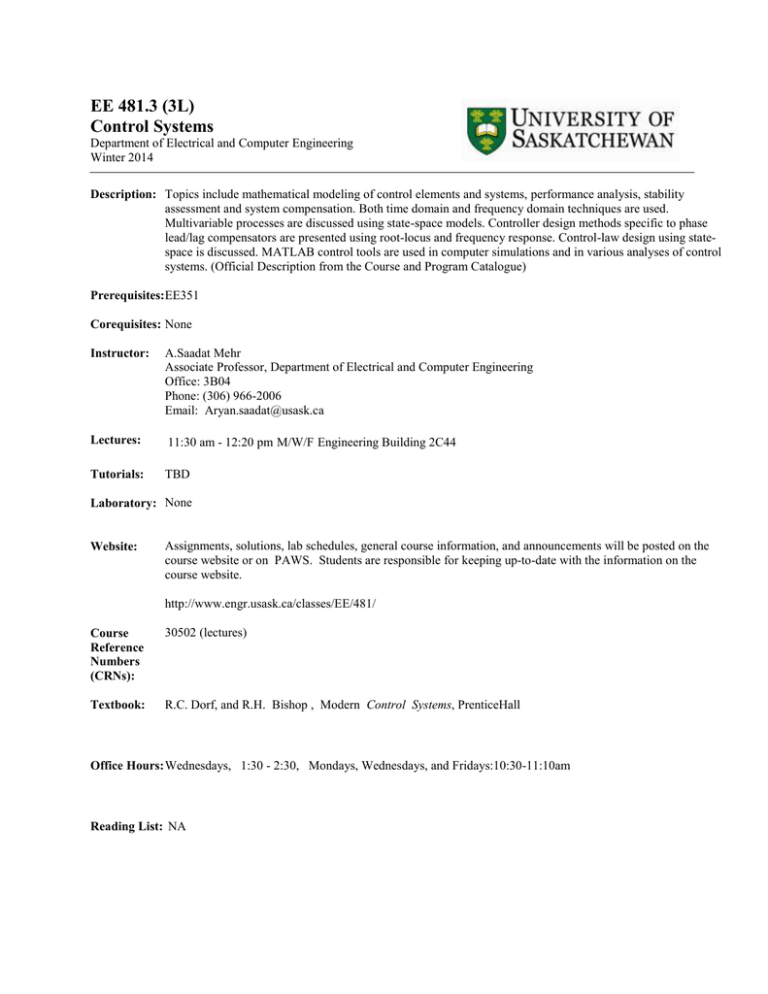
EE 481.3 (3L) Control Systems Department of Electrical and Computer Engineering Winter 2014 Description: Topics include mathematical modeling of control elements and systems, performance analysis, stability assessment and system compensation. Both time domain and frequency domain techniques are used. Multivariable processes are discussed using state-space models. Controller design methods specific to phase lead/lag compensators are presented using root-locus and frequency response. Control-law design using statespace is discussed. MATLAB control tools are used in computer simulations and in various analyses of control systems. (Official Description from the Course and Program Catalogue) Prerequisites:EE351 Corequisites: None Instructor: A.Saadat Mehr Associate Professor, Department of Electrical and Computer Engineering Office: 3B04 Phone: (306) 966-2006 Email: Aryan.saadat@usask.ca Lectures: 11:30 am - 12:20 pm M/W/F Engineering Building 2C44 Tutorials: TBD Laboratory: None Website: Assignments, solutions, lab schedules, general course information, and announcements will be posted on the course website or on PAWS. Students are responsible for keeping up-to-date with the information on the course website. http://www.engr.usask.ca/classes/EE/481/ Course Reference Numbers (CRNs): 30502 (lectures) Textbook: R.C. Dorf, and R.H. Bishop , Modern Control Systems, PrenticeHall Office Hours: Wednesdays, 1:30 - 2:30, Mondays, Wednesdays, and Fridays:10:30-11:10am Reading List: NA Assessment: The methods of assessment and their respective weightings are given below: Assignments, Quiz, and Class performance Project Midterm Exam Final Exam 15% 10% 25% 50% Final Grades: The final grades will be consistent with the “literal descriptors” specified in the university’s grading system. http://students.usask.ca/current/academics/grades/grading-system.php For information regarding appeals of final grades or other academic matters, please consult the University Council document on academic appeals. http://www.usask.ca/university_secretary/honesty/StudentAcademicAppeals.pdf Course Content: TOPIC TIME IN WEEKS CONCEPTS TO BE LEARNED Linear System Models 2 Mathematical models of physical systems, linearization, transfer functions representation. Time Response and Stability 2 Pole-zero plots, first and second order transient responses, bounded-input, bounded-output (BIBO) stability, RouthHurwitz stability criterion. Block Diagrams and Signal Flow Graphs 1 Block diagrams of systems, block diagram reduction, signal flow graphs of systems, Mason's formula. Feedback Control System Characteristics 2 Transient response, system specifications and performance analysis, effect of feedback, robustness, error analysis and steady-state analysis. Dynamic Compensation 1 Effect of adding poles and zeros, feedback compensation, leadlag compensation. Root Locus Analysis and Design 1.5 The root locus method, rules for root locus plotting and construction of root locus, root locus design. Frequency Response Analysis and Design 2.5 Frequency response, polar plots, Bode plots and Nyquist diagrams, stability criterion, gain and phase margins, compensator design in the frequency domain. State space analysis and design 1 State-space representation, full state feedback control design Assignments: Weekly assignments are to be given and are due the following week by 4:00 pm; please drop your assignments in the EE 481 Assignment Box. Please note that late assignments will not be accepted unless a legitimate reason (illness, religious conviction, etc.) exists and is discussed with the instructor. Solutions to the assignments will be prepared by the instructor, but your assignments will be marked by TAs. Solutions will be available on the course web-site. Tutorials: There will be about 8 sessions each about an hour-long, mostly for the review of the material, and problem solving. Quizzes: There will not be any prior announcement for most of the quizzes. Exams: There are a midterm test and a final exam: Important Dates: Student Conduct: In the test and exam, you can bring a two-sided formula sheet (8 by 11 in); but no books, class notes, or other materials are allowed. The midterm test will be conducted on Friday, Feb. 28, 2014 from 11:30 to 12:20 pm. Feb. 28, 2014 Mid-term April 8, 2014 Due date for the projects Ethical behaviour is an important part of engineering practice. Each professional engineering association has a Code of Ethics, which its members are expected to follow. Since students are in the process of becoming Professional Engineers, it is expected that students will conduct themselves in an ethical manner. The APEGS (Association of Professional Engineers and Geoscientists of Saskatchewan) Code of Ethics states that engineers shall “conduct themselves with fairness, courtesy and good faith towards clients, colleagues, employees and others; give credit where it is due and accept, as well as give, honest and fair professional criticism” (Section 20(e), The Engineering and Geoscience Professions Regulatory Bylaws, 1997). The first part of this statement discusses an engineer’s relationships with his or her colleagues. One of the ways in which engineering students can demonstrate courtesy to their colleagues is by helping to maintain an atmosphere that is conducive to learning, and minimizing disruptions in class. This includes arriving on time for lectures, turning cell phones and other electronic devices off during lectures, not leaving or entering the class at inopportune times, and refraining from talking to others while the instructor is talking. However, if you have questions at any time during lectures, please feel free to ask (chances are very good that someone else may have the same question as you do). For more information, please consult the University Council Guidelines for Academic Conduct. http://www.usask.ca/university_secretary/council/reports_forms/reports/guide_conduct.php Academic Honesty: The latter part of the above statement from the APEGS Code of Ethics discusses giving credit where it is due. At the University, this is addressed by university policies on academic integrity and academic misconduct. In this class, students are expected to submit their own individual work for academic credit, properly cite the work of others, and to follow the rules for examinations. Academic misconduct, plagiarism, and cheating will not be tolerated. Copying of assignments and lab reports is considered academic misconduct. Students are responsible for understanding the university’s policies on academic integrity and academic misconduct. For more information, please consult the University Council Regulations on Student Academic Misconduct and the university’s examination regulations. http://www.usask.ca/university_secretary/honesty/StudentAcademicMisconduct.pdf http://www.usask.ca/university_secretary/council/academiccourses.php Safety: The APEGS Code of Ethics also states that Professional Engineers shall “hold paramount the safety, health and welfare of the public and the protection of the environment and promote health and safety within the workplace” (Section 20(a), The Engineering and Geoscience Professions Regulatory Bylaws, 1997). Safety is taken very seriously by the Department of Electrical and Computer Engineering. Students are expected to work in a safe manner, follow all safety instructions, and use any personal protective equipment provided. Students failing to observe the safety rules in any laboratory will be asked to leave. Laboratory Learning Outcomes: Upon completion of this Lab the students should be able to: 1. Learning outcome 2. Learning outcome 3. Learning outcome Learning outcome(s) for each of the scheduled labs Course Learning Outcomes: Upon completing this course students will be able to: 1. Learning outcome 2. Learning outcome 3. Learning outcome Attribute Mapping: Learning Outcome 1 2 3 A1 A2 A3 Level of Performance* Attribute** A4 A5 A6 A7 **Attributes: A1 Knowledge base for engineering A2 Problem analysis A3 Investigation A4 Design A5 Use of engineering tools A6 Individual and team work A7 Communication skills A8 Professionalism A9 Impact of engineering on society and the environment A10 Ethics and equity A11 Economics and project management A12 Life-long learning A8 A9 A10 A11 A12 *Levels of Performance: 1 - Knowledge of the skills/concepts/tools but not using them to solve problems. 2 - Using the skills/concepts/tools to solve directed problems. (“Directed” indicates that students are told what tools to use.) 3 - Selecting and using the skills/concepts/tools to solve non-directed, non-open-ended problems. (Students have a number of S/C/T to choose from and need to decide which to employ. Problems will have a definite solution.) 4 - Applying the appropriate skills/concepts/tools to solve open-ended problems. (Students have a number of S/C/T to choose from and need to decide which to employ. Problems will have multiple solution paths leading to possibly more than one acceptable solution.) Accreditation Unit (AU) Mapping: (% of total class AU) Math - Natural Science - Complementary Studies - Engineering Science - Engineering Design - Assessment Mapping: Component Weighting Methods of Feedback*** ***Methods of Feedback: F – formative (written comments and/or oral discussions) S – summative (number grades) Learning Outcomes Evaluated
